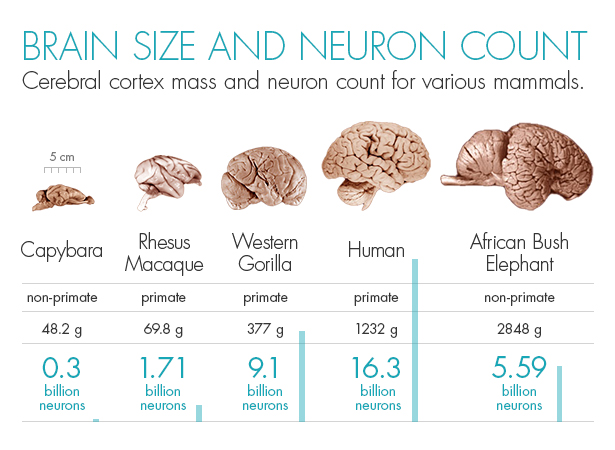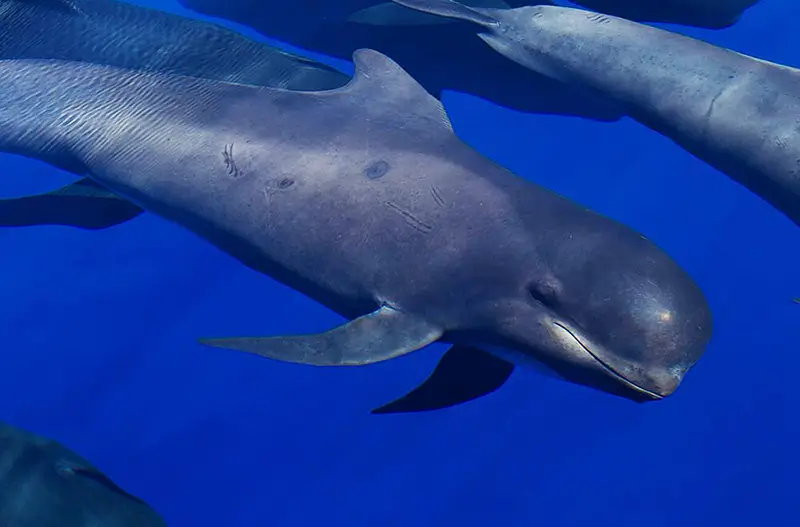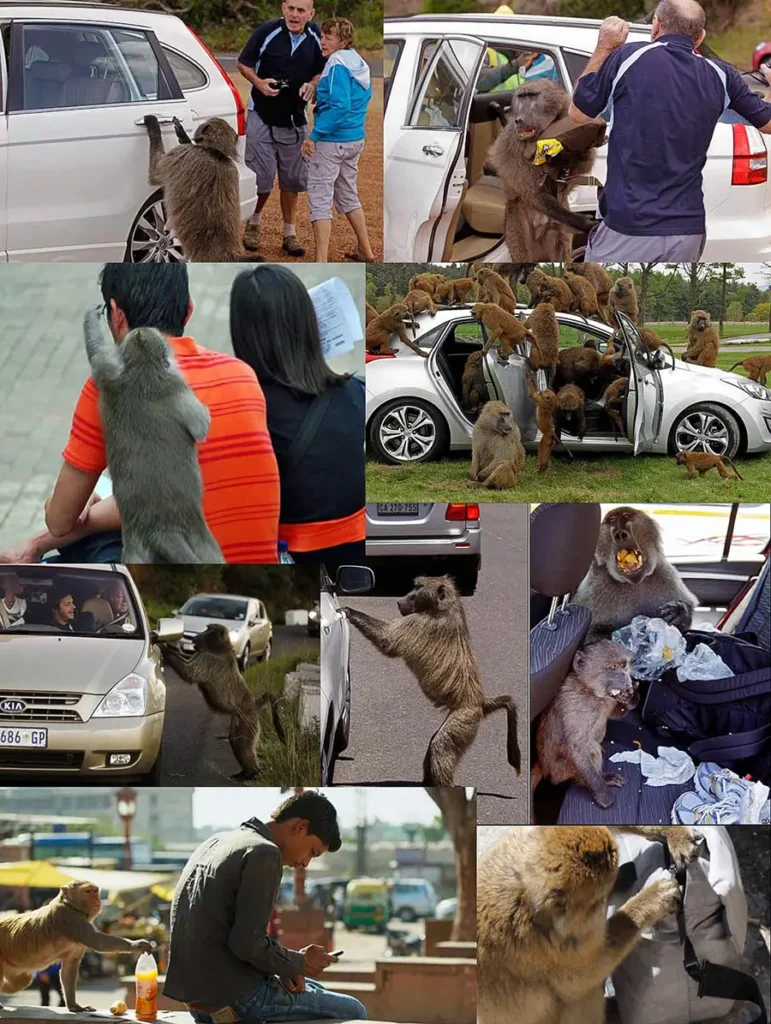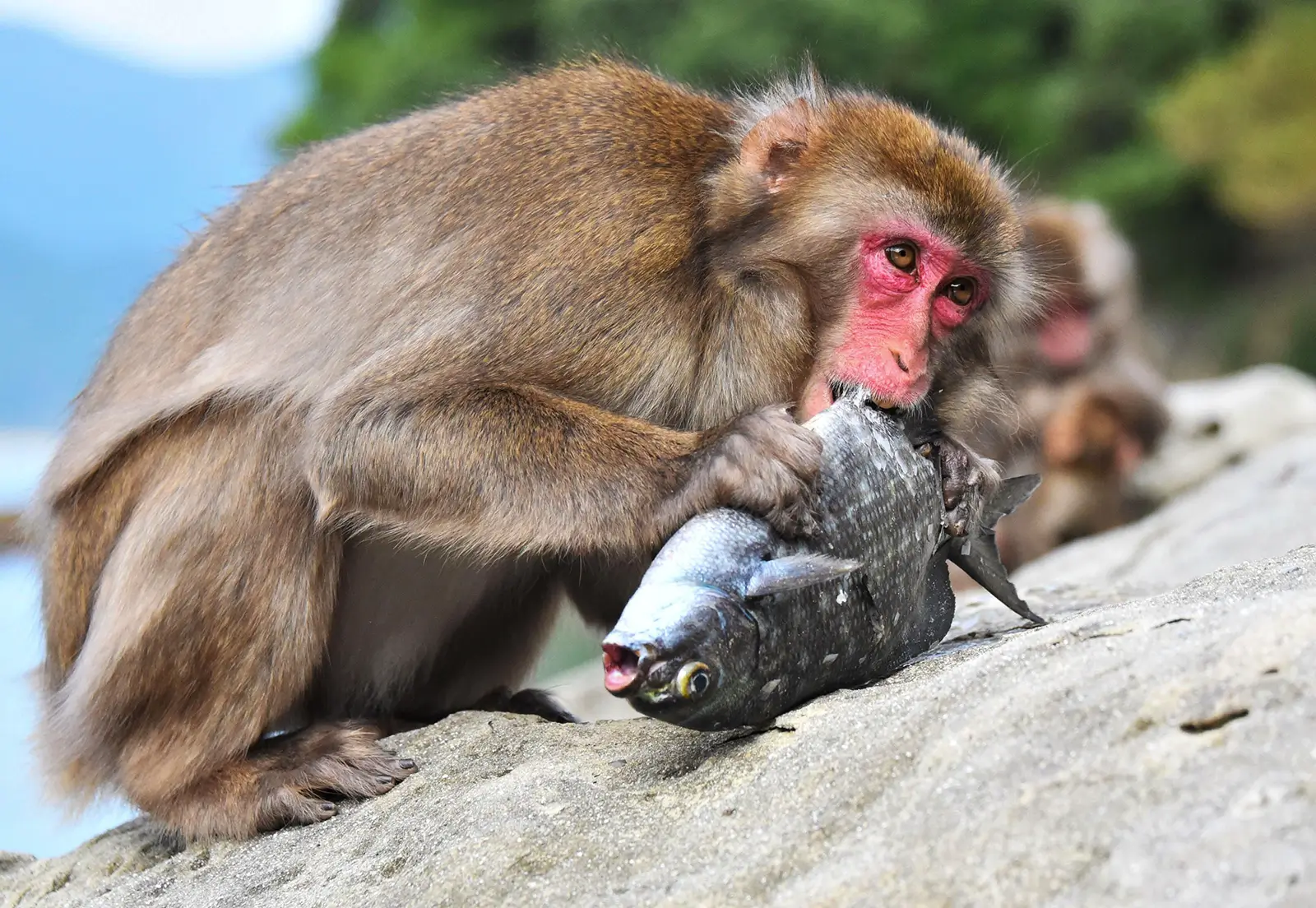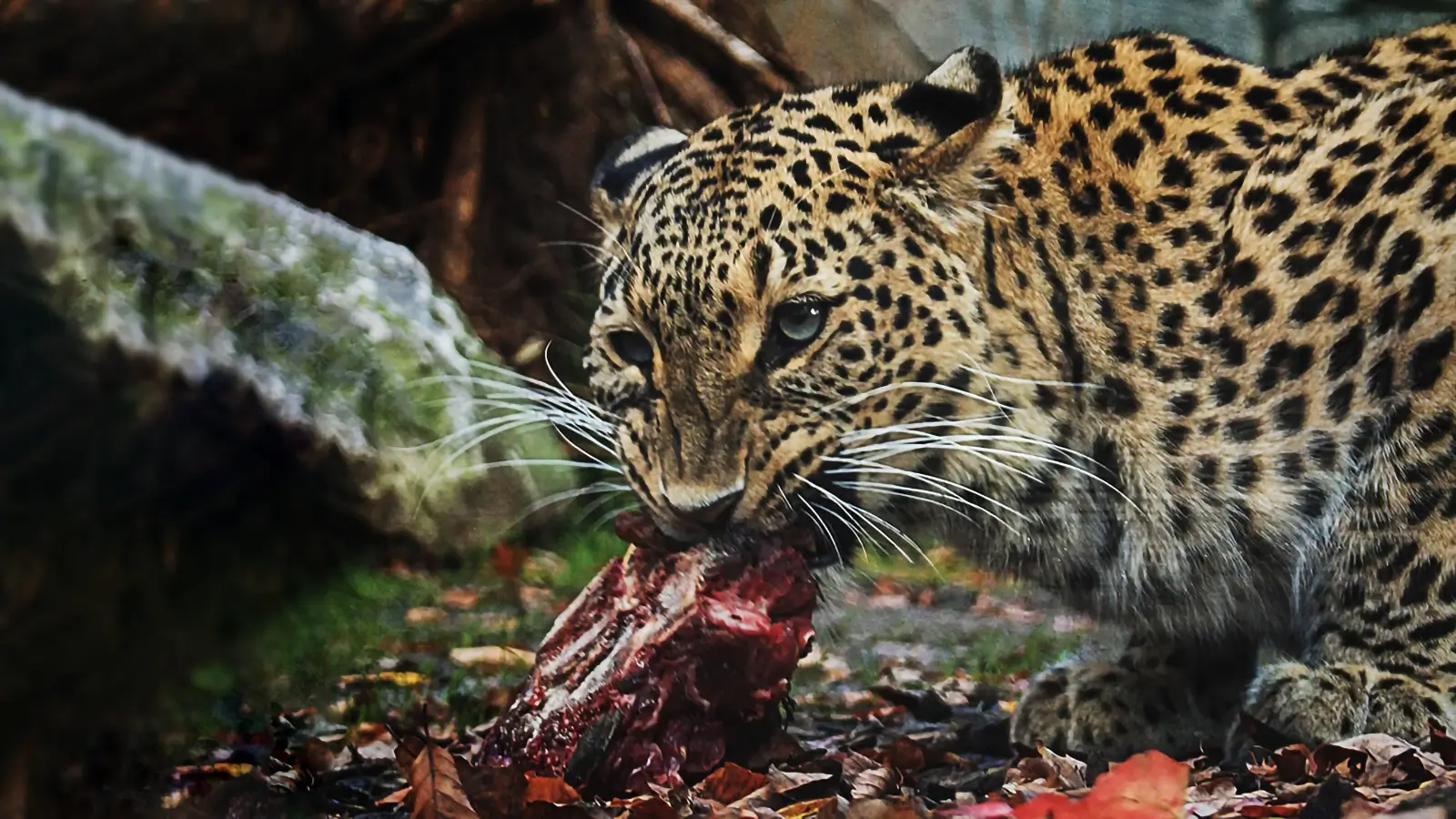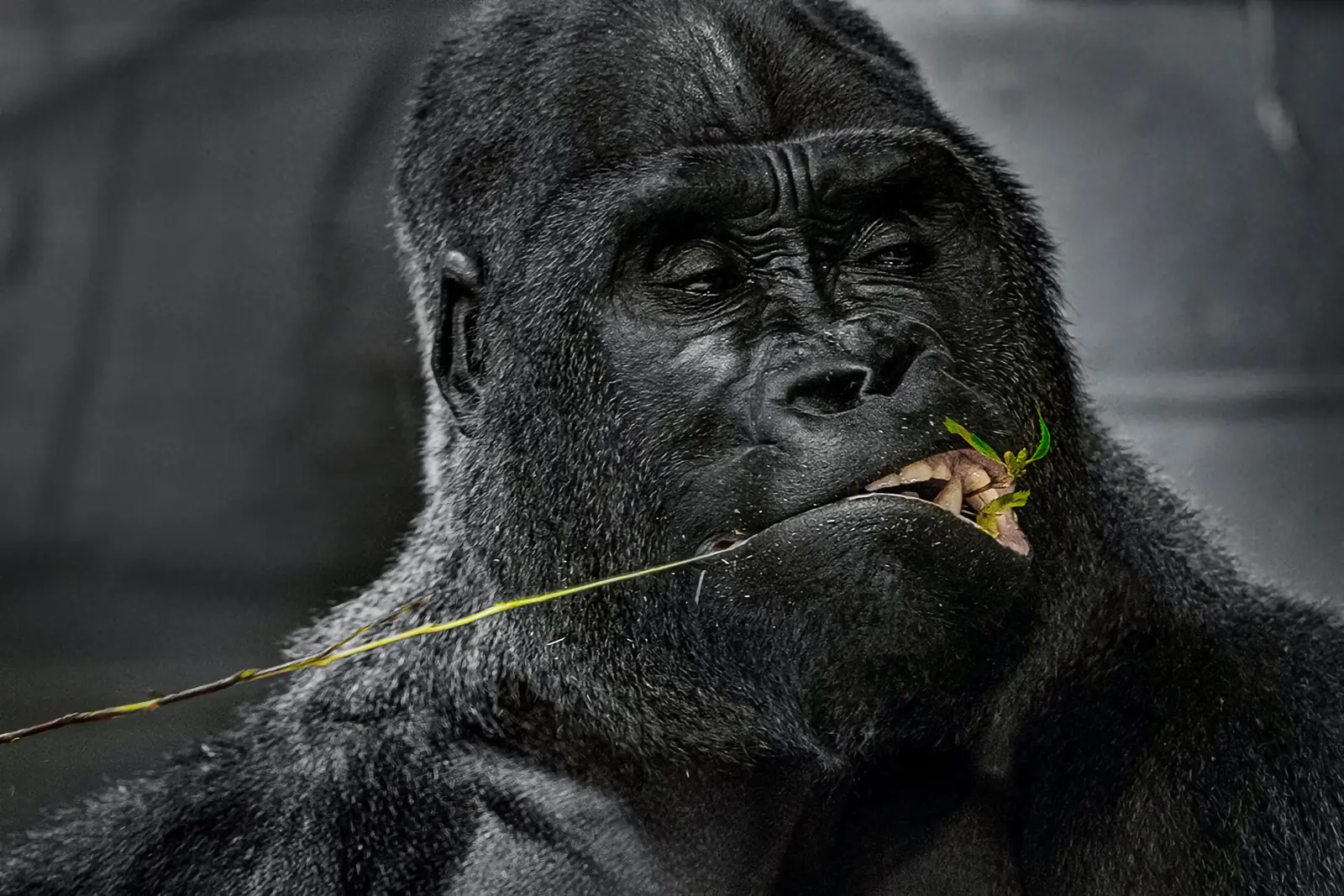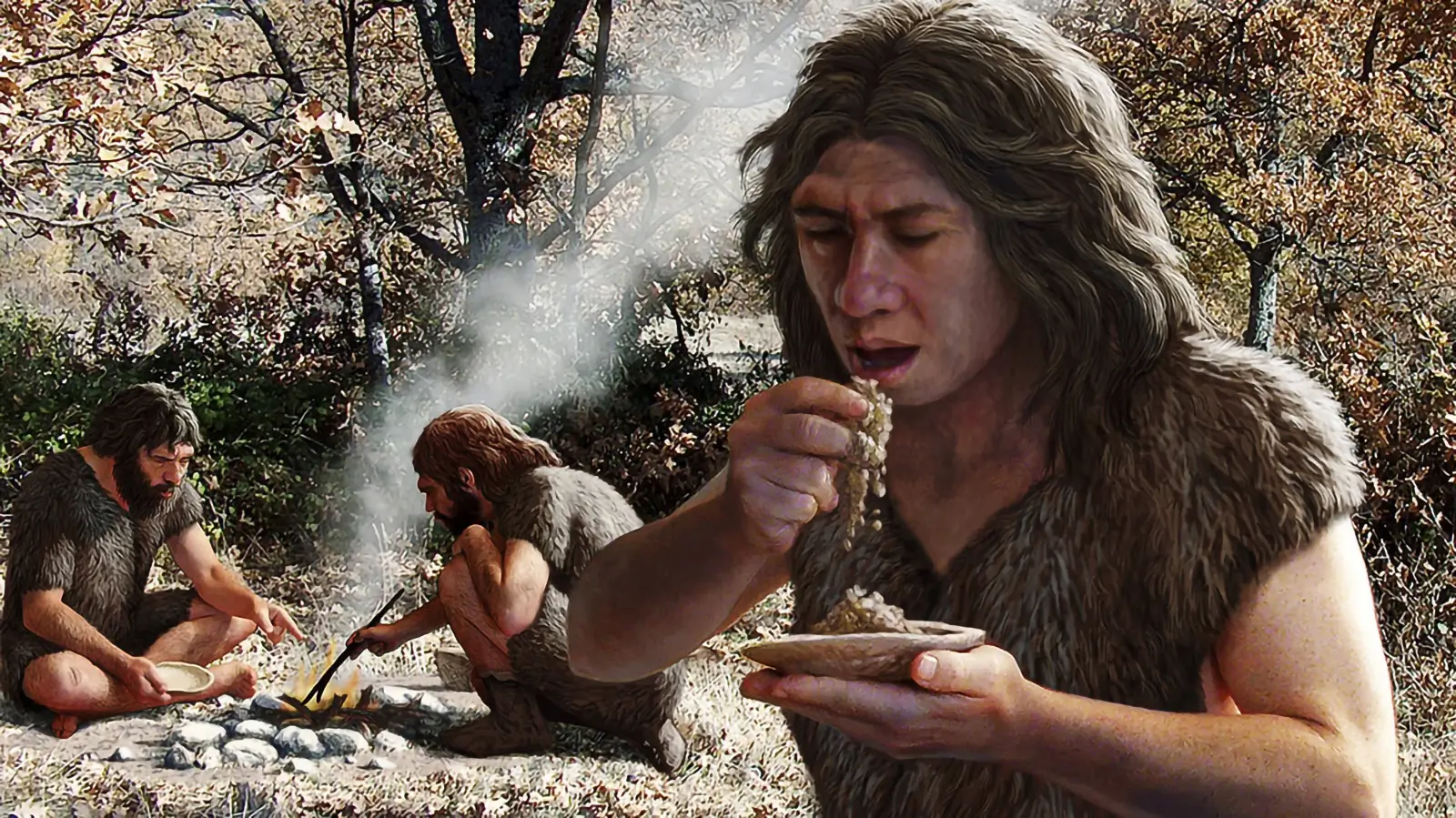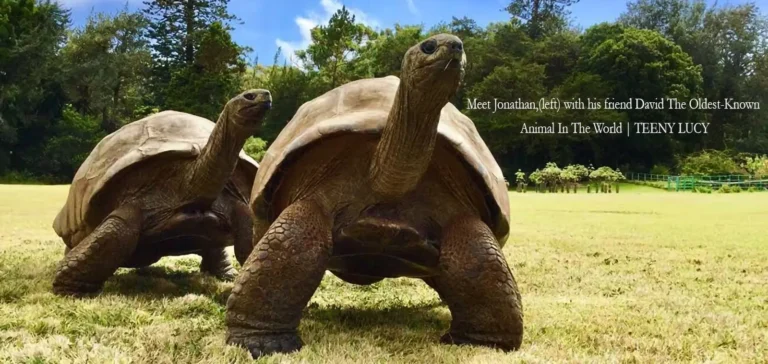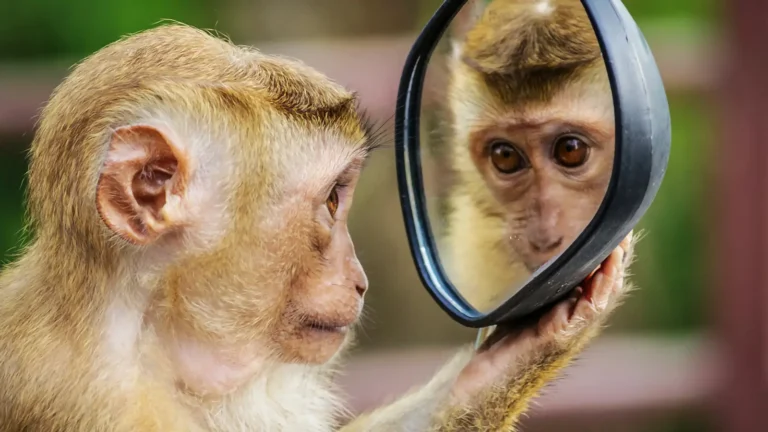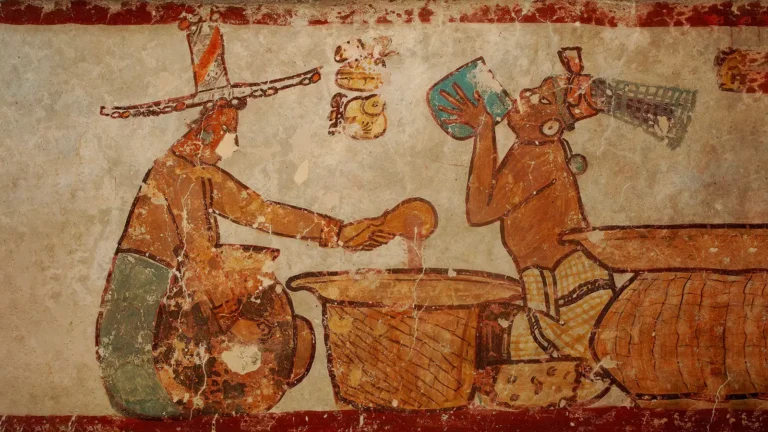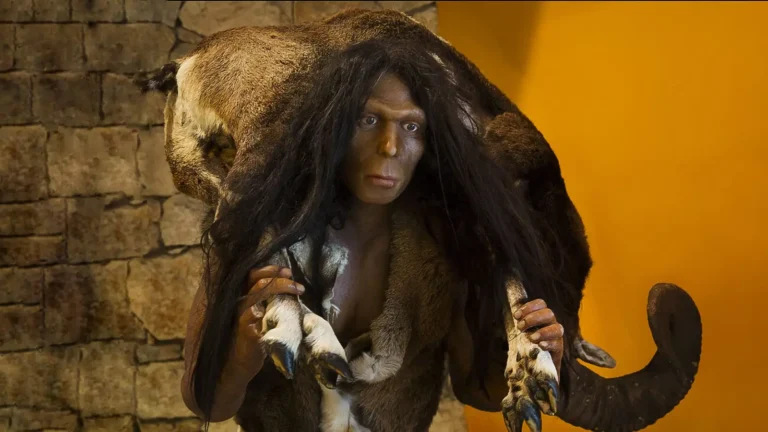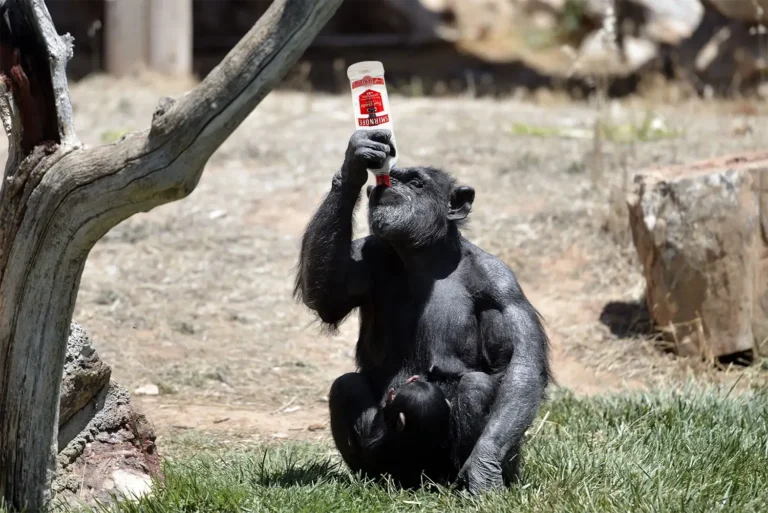Humano de carne, ou seja, o mito?- O animal cognição
Não somos mais inteligentes espécies se nós cientificamente medida animal cognição. As barbatanas longas baleia-piloto cérebro neocortical parte contém mais neurônios do que os nossos próprios.
Milos Pokimica
Escrito por: Milos Pokimica
Revisto Clinicamente Por: Dr. Xiùying Wáng, M.D.
Actualizado em 9 de Junho de 2023Já alguma vez pensou no que o seu cão está a pensar? Ou como é que os golfinhos aprendem a cooperar para apanhar peixe? Ou se um chimpanzé pode aprender a linguagem gestual? O campo da ciência que investiga a capacidade mental dos animais chama-se cognição animal, que é o estudo das mentes dos animais, particularmente como eles pensam e aprendem. Investigar não só o que os animais fazem, mas também os processos mentais que sustentam o seu comportamento.
A cognição animal é um assunto complicado. Até aos anos 60, o termo cognição animal era considerado um oximoro porque os animais eram considerados sistemas simples que simplesmente respondiam a vários estímulos de forma evolutiva, pré-programados e invariantes. Contudo, à medida que os investigadores começaram a observar de perto os animais no laboratório e na natureza, aperceberam-se de que esta visão simplista não explicava os padrões de comportamento observados. Embora haja tantas definições de cognição animal como há investigadores, a maioria dos cientistas concorda que a cognição animal, tal como a sua contraparte humana, envolve essencialmente o processamento de informação: como um sujeito, dentro do seu sistema perceptivo específico da espécie (auditivo, visual, olfactivo, gustativo, somatosensorial), recebe dados do mundo em que habita (incluindo dados de outros indivíduos), e usa o seu cérebro para procriar usando a sua neurobiologia específica da espécie. Nas últimas décadas, o estudo da cognição animal expandiu-se para incluir uma gama espantosamente diversificada de espécies, desde insectos aos nossos parentes mais próximos, e primatas não humanos, bem como uma vasta gama de técnicas.
O campo pode ser subdividido em vários subtópicos. Os investigadores que se especializam em psicologia comparada, por exemplo, examinam um tipo específico de cognição, como a competência numérica, em várias espécies, enquanto os investigadores que se especializam em etologia cognitiva analisam a forma como os traços evolutivos de uma determinada espécie lhe permitem interagir de várias formas com um ou mais aspectos do seu ambiente. Como todos os estudos envolvem vários aspectos da atenção, categorização, memória, raciocínio e resolução de problemas, a maioria dos investigadores realiza estudos que se sobrepõem a vários subtópicos diferentes e, por vezes, as respostas a questões científicas só podem ser encontradas através da combinação de investigação laboratorial e de campo. Em todos os casos, os cientistas realizam experiências cuidadosamente controladas ou estudos de observação bem planeados.
Hoje temos uma linha de estudos, mas num passado não tão distante, mesmo o termo cognição animal foi negado ao ponto de mesmo o comportamento humano em primatas ser considerado um desencadeamento instintivo, sem inteligência. Os humanos eram a única espécie inteligente, os humanos eram a única espécie no planeta Terra que tinha alma, e Deus fez neles a imagem de si próprio, os humanos estão aqui para governar e todos os animais, independentemente do seu nível de inteligência, estão lá apenas para serem uma fonte de alimento. Esta opinião ainda prevalece na maioria da população e um dos mitos que ainda existe é que tudo isto se deve ao facto de, de alguma forma, crescermos um cérebro maior na idade da pedra quando começámos a comer carne como uma fonte adicional de proteínas e energia que permitiu o nosso cérebro crescer.
O problema com esta crença é que não existe uma relação particular entre tamanho do cérebro e inteligência em primeiro lugar, e mesmo que haja uma história sobre cognição animal na realidade não é realmente uma história sobre carne consumo ou consumo humano de carne. É mais complicado do que isso.
Os seres humanos adultos têm cerca de 2,5 kg de peso cerebral, os golfinhos têm 3,5 kg, um elefante tem cerca de 10,5 kg e os cachalotes têm cerca de 3,5 kg. Os predadores, regra geral, tendem a ter um cérebro relativamente maior do que o dos animais que predam. Os mamíferos placentários também tendem a ter cérebros maiores do que os marsupiais, como o gambá. Existe uma fórmula conhecida como quociente de encefalização para medir o tamanho do cérebro de uma espécie em relação às expectativas baseadas no tamanho esperado do seu corpo. Ao longo de toda a evolução do Homo sapiens, a caraterística predominante foi um aumento constante do tamanho do cérebro. A verdade é que grande parte desse tamanho pode ser atribuído aos aumentos correspondentes no tamanho do corpo. Os neandertais, por exemplo, e muitas pessoas não sabem disso, costumavam ter cérebros maiores do que os do Homo sapiens moderno. O que é mais importante do que o tamanho é a forma como o cérebro está ligado e o número de neurónios.
O que é único no cérebro humano é que a contagem de neurónios numa parte específica do cérebro, chamada córtex cerebral, é muito mais elevada do que em qualquer outro animal na Terra. O cérebro humano tem 86 mil milhões de neurónios se os contarmos todos; 69 mil milhões no cerebelo; 16 mil milhões no córtex cerebral e mil milhões no tronco cerebral e nas suas extensões até ao núcleo do cérebro. O cerebelo orquestra as funções corporais essenciais e o movimento e é uma parte primitiva do cérebro, ou, digamos, uma parte essencial. O córtex cerebral é a coroa espessa do cérebro, a verdadeira. É responsável pela consciência de si, pela linguagem, pela resolução de problemas, pelos talentos mentais sofisticados e pelo pensamento abstrato. Se quisermos medir a inteligência de uma espécie, temos de contar os neurónios do córtex cerebral. É isso mesmo. É assim tão simples. Por exemplo, o cérebro do elefante é três vezes maior do que o nosso e tem 251 mil milhões de neurónios no cerebelo, que é necessário para gerir a sua enorme tromba, mas apenas 5,6 mil milhões no córtex. Para que fique claro, o elefante é considerado uma espécie altamente inteligente. Se olharmos para os grandes símios, somos os vencedores. Temos 16 mil milhões de neurónios no nosso córtex, mas eu estava a referir-me apenas aos grandes símios. O Homo sapiens parece ter o número mais significativo de neurónios corticais de todas as espécies da Terra.
Oh, espera. Acabei de mentir. Nós não somos os mais inteligentes. A baleia-piloto de barbatanas longas é que é. A sua parte neocortical do cérebro contém substancialmente mais neurónios e células gliais do que o neocórtex de outras espécies com cérebros grandes, incluindo os humanos (Mortensen et al., 2014).
Somos as espécies mais inteligentes do que qualquer outra se contarmos apenas as espécies animais terrestres, e temos braços, pernas e fala para que possamos construir tecnologia, mas adivinhem o que, por estas medidas, não somos as espécies mais inteligentes da Terra. A baleia piloto de barbatanas longas é.
O maior número de neurónios no córtex cerebral é o que torna as espécies inteligentes. Os primatas desenvolveram uma forma de colocar muito mais neurónios nessa área do que os outros mamíferos. Os grandes símios são minúsculos quando comparados com os elefantes e as baleias, mas os seus córtices são muito mais densos. Os orangotangos e os gorilas têm 9 mil milhões de neurónios corticais e os chimpanzés têm 6 mil milhões. Assim, por estas medidas, os seres humanos são 44% mais inteligentes do que os orangotangos, por exemplo, porque temos 16 mil milhões de neurónios e eles têm 9. Assim, se o QI médio dos humanos é 100, o QI dos orangotangos seria 56. Os chimpanzés situam-se normalmente entre os 35 e os 50. Não é mau de todo. Mesmo os macacos pequenos são muito inteligentes e mais inteligentes do que os seus congéneres em tamanho. Quando temos de pensar sempre que precisamos de comer, isso obriga o cérebro a desenvolver estratégias de procura de alimentos. Vou dar um exemplo. Em locais como a África do Sul ou a Índia, existe um grande número de macacos urbanos. Estes animais selvagens vieram por sua própria vontade para as cidades em busca de comida. Para eles, somos apenas mais uma espécie de macaco. Não têm qualquer medo de nós. Consideram-nos não assustadores porque somos mais lentos do que eles e, em grande medida, mais fracos, e porque temos toda a comida à nossa disposição em todo o lado. Para os macacos selvagens, é mais fácil procurar comida no ambiente humano. Os cães vadios fazem-no farejando a comida, usam o nariz, mas os macacos usam o cérebro para fazer o mesmo. Por causa dos filmes e da cultura média, é provável que os norte-americanos pensem que os macacos são animais meigos e fofos com os quais se podem divertir e que são super giros quando vestem roupas humanas. Na vida real, eles são tudo menos bonitos. Por exemplo, são conhecidos por vaguearem pelos bairros em bandos. Os bandos de babuínos andam à solta em partes do mundo como os subúrbios da África do Sul. Viajam num bando de cerca de 30, e todos se movem seguindo o líder, mas estão tão afastados que é difícil impedi-los de deslizar para áreas construídas. Conseguem atravessar paredes e telhados a grande velocidade. Os bandos têm sempre um líder e andam à procura das suas coisas. Arrombamento e invasão, comportamento agressivo e roubo. É a vida normal dos bandidos e não tem piada nenhuma. Entram em casa das pessoas para roubar comida, arrombam carros e sabem como abrir as portas ou qualquer outra coisa do género. Se nos virem fazer isso, também o podem fazer. Eles são muito inteligentes.
Pensemos no seguinte. Os pequenos macacos cerebrais vêem-nos utilizar a tecnologia e depois começam a utilizá-la também para eles próprios. Aprendem sozinhos a abrir janelas, a abrir portas de carros, frigoríficos e apartamentos, podem esgueirar-se nas nossas costas e roubar, podem abrir fechos de correr, etc.
Eles não estão apenas conscientes de si próprios, estão conscientes da sua forma de pensar para se poderem colocar na sua posição e prever como vai reagir para que o possam manipular. Não estou a brincar. São conhecidos por se esgueirarem nas tuas costas e roubarem coisas, e são conhecidos por te atraírem para fora.
Um deles rouba à nossa frente e começa a correr e, quando saímos para o perseguir, outros macacos que não vimos entram e roubam coisas enquanto estamos a perseguir esse macaco. Isto não é cognição animal, é cognição plena. E se isso não for suficiente, eles vão simplesmente tirá-lo das suas mãos fisicamente. Se tiveres algum problema com isso, então eles vão dar-te uma bofetada na cara. Eles não têm medo de nós. E podemos dizer que isso já é suficientemente mau, mas há mais. Quando estão aborrecidos, vão andar à volta das pessoas e divertir-se. O vice-presidente da câmara de Nova Deli morreu devido a um ataque de macacos. Não directamente, não foram eles que o atacaram, mas ele tropeçou na varanda quando tentava lutar contra eles no seu apartamento. São agressivos e inteligentes. De acordo com um estudo (Grainger et al., 2012), os babuínos não têm uma linguagem conhecida ou algo semelhante, mas foram capazes de separar com exactidão palavras inglesas reais de sequências de letras sem sentido. Se os babuínos têm a capacidade física de falar, o seu nível de cognição animal é tal que terão uma linguagem escrita real, porque têm a inteligência adequada para isso, uma vez que a capacidade de distinguir palavras reais de palavras não reais é o primeiro passo no processo de leitura.
Comparemos, por exemplo, espécies de macacos herbívoros com espécies carnívoras aproximadamente do mesmo tamanho. No documentário "Animals Like Us", os realizadores documentaram o rapto de cachorros de cães selvagens por babuínos e a sua criação na sua própria tribo de babuínos como membros ou animais de estimação. Os babuínos e os cães têm tamanhos semelhantes. O clip da série, que foi filmado numa lixeira perto de Ta'if, na Arábia Saudita, mostra um babuíno macho a arrastar um cachorrinho para longe da sua toca enquanto este grita pela mãe. Os cães roubados crescem com a espécie babuíno, como um membro da família ou um membro de um grupo. Comiam com eles, dormiam e deslocavam-se em conjunto. Os babuínos cuidam deles e brincam com eles, e isso é importante. Os babuínos só brincam com membros da família. A relação parece ser benéfica tanto para o cão como para o babuíno. Os cães selvagens domesticados desempenham a mesma função que têm na sociedade humana, que é a de guardar o território. Mantêm as matilhas de cães selvagens afastadas dos macacos durante a noite, enquanto estes dormem e, em troca, são tratados com amor e carinho, tal como os humanos tratariam um animal de estimação da família. Note-se que, nesta situação, é importante compreender que os cães tinham um estatuto mais igual na tribo, não eram animais de estimação, uma vez que os macacos não os alimentavam. Os cães são carnívoros e comiam ratos e outros pequenos animais e carne que conseguiam encontrar. Não comiam frutas e legumes, nem outros grãos e outros alimentos que se encontravam nas lixeiras, de origem vegetal, que os babuínos comiam. Não havia competição direta pela comida, pelo que tinham uma tribo comum numa relação simbiótica. Este vídeo gerou muita polémica. As pessoas têm dificuldade em aceitar comportamentos semelhantes aos humanos em animais, devido à nossa autoimagem. Se houve uma verdadeira ligação familiar entre os babuínos e os cães, mais uma vez, não saberemos até que seja feita uma investigação real e científica. Há mais um vídeo que mostra um babuíno a maltratar um cachorro que apareceu. Um estudante de Cornell chamado Luke Seitz filmou-o. Ele estava numa viagem de investigação de aves na Etiópia quando gravou uma situação semelhante de um babuíno a carregar um cão "como se fosse um animal de estimação". Ele também aparentemente observou este comportamento durante um período de dias, por isso não foi apenas um acaso.
Num outro caso em Guassa Plateau, o primatologista etíope Vivek Venkataraman observou uma cena notável: lobos e macacos casualmente se misturam. Em circunstâncias normais, os macacos são presas, mas nesta situação, os lobos não pareciam ter interesse em comer babuínos. Os babuínos e especialmente os jovens são presas fáceis para os lobos. De facto, pareciam fazer tudo o que podiam para fugir a qualquer confronto. Ignoravam-se mutuamente e passavam horas a vaguear pelos grandes rebanhos de gelada à procura de roedores. Porque não competem por uma fonte primária de alimento e atacar a grande colónia de macacos resultaria em guerra e coisas más aconteceriam a ambos eles, que coabitam. Os humanos e os gatos selvagens tinham este tipo de acordo. A domesticação de gatos selvagens aconteceu ao mesmo tempo no Médio Oriente e no Egipto. Os gatos selvagens começaram a passar muito tempo em aldeias humanas. Havia muitos ratos presentes, devido à acumulação de armazéns de cereais após a domesticação de plantas selvagens. Era a mesma relação simbiótica. Utilizávamos gatos selvagens para baixar a contagem de ratos; era benéfico para nós tolerá-los. Não os alimentávamos directamente. Além disso, os ratos podem atrair outros predadores, como as cobras, e isso pode ser mortal. Assim, tolerámos os gatos selvagens, e os gatos selvagens toleraram-nos porque somos a fonte da sua nova abundância alimentar e, com o tempo, a domesticação aconteceu. Os macacos também são conhecidos por adoptarem pessoas.
Quando criança de apenas cinco anos de idade, Marina Chapman foi raptada. Uma razão possível era pedir um resgate, mas quando os criminosos não o receberam, abandonaram-na simplesmente na selva colombiana. Durante cerca de cinco anos, quando criança, ela viveu na selva. Ela diz que foi acolhida por um grupo de macacos capuchinhos. Estes tipos de macacos são conhecidos por aceitarem crianças pequenas no seu aprisco. Ela aprendeu a forragear para obter alimentos copiando-os. Ela diz que os macacos ensinaram-na a fazê-lo, mas em qualquer caso, ela sobreviveu. Ela voltou à civilização humana quando foi apanhada por caçadores e vendida a um bordel (nessa altura, não era capaz de falar a língua humana). Acabou por conseguir fugir do bordel, viveu nas ruas e, no final, tornou-se escrava da família mafiosa.
A carne humana é um mito justo e humano. Não importa se estamos a falar de galinhas, porcos ou qualquer outro animal. Os porcos são pelo menos tão inteligentes como uma criança humana de três anos, as vacas desenvolvem laços profundos e duradouros com a sua família e amigos, as galinhas são capazes de distinguir mais de 100 faces diferentes dos membros da sua espécie, e têm 30 chamadas diferentes para assinalar trastes diferentes. A cognição animal é um vasto tópico.
De Kanzi, o bonobo, a Akeakamai, o golfinho. Kenzi, por exemplo, aprendeu mais de 500 lexigramas. Ainda mais importante, conseguiu ligar estes lexigramas para representar a forma de pequenas frases. Num estudo realizado em 1993, ele teve um desempenho melhor do que um humano de 2 anos de idade ao responder a pedidos verbais.

Akeakamai e Phoenix (Wikipedia), o seu companheiro de tanque golfinhos, foram ensinados a reconhecer as palavras. Akeakamai foi ensinado a palavras que eram representadas por diferentes gestos feitos pelas mãos de um treinador humano. Phoenix aprendeu ouvindo as palavras através de sons electrónicos gerados por computador. Estes sons eram reproduzidos através de um altifalante subaquático. Ambos os golfinhos aprenderam com sucesso palavras individuais e eventualmente cordas de palavras ou sentenças. Impressionantemente, os golfinhos puderam compreender as instruções dadas com diferentes estruturas gramaticais e diferentes ordens de palavras. Compreenderam a diferença entre instruções como "Levar a bola ao cesto" e "Levar a bola ao cesto". Quando executaram correctamente as acções necessárias, os golfinhos mostraram que compreendiam os elementos da linguagem. Isto é inteligência ao nível dos humanos. Ainda mais notável, os golfinhos pareciam ser capazes de colaborar de forma criativa. Os gestores humanos pediram aos golfinhos para inventarem os seus próprios truques em conjunto, usando tandem e criando comandos. Os golfinhos responderam com um comportamento sincronizado à sua escolha, tal como mergulhar para trás ou contorcer as suas caudas. Militares do mundo até treinaram e experimentaram golfinhos com a ideia de criar soldados a partir deles. Os golfinhos estão a um nível de cognição que varia muito de acordo com os humanos. No entanto, este facto é irrelevante para nós.
O reconhecimento não tem nada a ver com isto
Não somos a única espécie inteligente e quando olhamos para babuínos e cães um herbívoro, outro carnívoro, os babuínos são de longe mais inteligentes. Além disso, o próprio cão é um animal muito inteligente. É um grande dogma na ciência que, de alguma forma, a fonte de carne recentemente incorporada igual a alguns por cento do total de calorias consumidas sob a forma de medula óssea na dieta inicial dos hominídeos desenvolveu o nosso grande cérebro e que a carne é essencial para a nossa inteligência e tem de ser parte integrante da dieta moderna.
Ao mesmo tempo, não queremos reconhecer nenhuma forma de cognição animal. a cognição animal é um tópico que será cada vez mais importante à medida que os avanços nas neurociências continuarem. A cognição animal está hoje em dia num entendimento científico de que o antropomorfismo já não é um termo dogmático e hoje em dia os cientistas rejeitam tal linguagem. Hoje em dia, os cientistas envolvidos no campo da cognição animal acreditam que todos os animais experimentam emoções, por exemplo. Não só isso, mas também as emoções são vitais para a sua sobrevivência. A cognição animal também desempenhará no futuro um papel nas nossas próprias percepções e teremos de responder a algumas questões específicas.
Será que vamos dar direitos humanos a algumas espécies de animais? Se fizéssemos quais seriam as consequências? Até onde deve ir a cognição animal antes de considerarmos um animal como um candidato aos direitos humanos? Consideraríamos uma morte de um corvo como uma morte de uma criança humana de 7 anos e, se não por que não? Pararíamos as experiências com primatas? Deixariam os japoneses de matar e comer carne de golfinhos? Seriam as pessoas colocadas na prisão se torturassem e matassem animais? E as espécies animais que consideramos como fontes de alimento?
Referências:
- Mortensen, H. S., Pakkenberg, B., Dam, M., Dietz, R., Sonne, C., Mikkelsen, B., & Eriksen, N. (2014). Relações quantitativas no neocórtex delfinídeo. Fronteiras da neuroanatomia, 8, 132. https://doi.org/10.3389/fnana.2014.00132
- Grainger, J., Dufau, S., Montant, M., Ziegler, J. C., & Fagot, J. (2012). Processamento ortográfico em babuínos (Papio papio). Ciência (Nova Iorque, N.Y.), 336(6078), 245-248. https://doi.org/10.1126/science.1218152
Publicações Relacionadas
Você tem alguma dúvida sobre saúde e nutrição?
Eu adoraria ouvir de você e respondê-las em meu próximo post. Agradeço sua contribuição e opinião e espero ouvir de você em breve. Eu também convido você a siga-nos no Facebook, Instagram e Pinterest para mais conteúdos sobre dieta, nutrição e saúde. Pode deixar um comentário e ligar-se a outros entusiastas da saúde, partilhar as suas dicas e experiências e obter apoio e encorajamento da nossa equipa e comunidade.
Espero que este post tenha sido informativo e agradável para si e que esteja preparado para aplicar os conhecimentos que aprendeu. Se achou este post útil, por favor partilhá-lo com os seus amigos e familiares que também possam beneficiar com isso. Nunca se sabe quem poderá precisar de alguma orientação e apoio no seu percurso de saúde.
– Você Também Pode Gostar –

Aprender Sobre Nutrição
Milos Pokimica é médico de medicina natural, nutricionista clínico, escritor de saúde e nutrição médica, e conselheiro em ciências nutricionais. Autor da série de livros Go Vegan? Revisão de Ciênciaopera também o website de saúde natural GoVeganWay.com
Medical Disclaimer
GoVeganWay.com traz análises das pesquisas mais recentes sobre nutrição e saúde. As informações fornecidas representam a opinião pessoal do autor e não pretendem nem implicam substituir aconselhamento, diagnóstico ou tratamento médico profissional. As informações fornecidas são apenas para fins informativos e não se destinam a servir como substituto para consulta, diagnóstico e/ou tratamento médico de um médico ou profissional de saúde qualificado.NUNCA DESCONSIDERE o CONSELHO MÉDICO PROFISSIONAL OU adiar a BUSCA de TRATAMENTO MÉDICO por causa DE ALGO QUE TENHA LIDO OU ACESSADO por MEIO de GoVeganWay.com
NUNCA APLIQUE QUAISQUER MUDANÇAS de estilo de VIDA OU QUALQUER MUDANÇA COMO UMA CONSEQUÊNCIA DE ALGO QUE TENHA LIDO NO GoVeganWay.com ANTES de CONSULTORIA de LICENÇA MÉDICA.
No caso de uma emergência médica, ligue para o médico ou para o 911 imediatamente. GoVeganWay.com não recomenda ou endossa qualquer específicos, grupos, organizações, exames, médicos, produtos, procedimentos, opiniões ou outras informações que podem ser mencionadas dentro.
Sugestões do Editor –
Milos Pokimica é escritor especializado em saúde e nutrição e consultor em ciências nutricionais. Autor da série de livros Go Vegan? Revisão de Ciênciaopera também o website de saúde natural GoVeganWay.com
Artigos Mais Recentes -
Superior De Saúde De Notícias — ScienceDaily
- Why consciousness exists at allon Dezembro 15, 2025
Consciousness evolved in stages, starting with basic survival responses like pain and alarm, then expanding into focused awareness and self-reflection. These layers help organisms avoid danger, learn from the environment, and coordinate socially. Surprisingly, birds show many of these same traits, from subjective perception to basic self-awareness. This suggests consciousness is far older and more widespread than once believed.
- AI found a way to stop a virus before it enters cellson Dezembro 15, 2025
Researchers discovered a hidden molecular “switch” that herpes viruses rely on to invade cells. By combining AI, simulations, and lab experiments, they identified and altered a single amino acid that shut down viral entry. What once might have taken years was achieved far faster using computational tools. The findings open new possibilities for designing future antiviral treatments.
- New study shows some plant-based diets may raise heart disease riskon Dezembro 15, 2025
Researchers tracking over 63,000 adults found that high-quality, minimally processed plant foods significantly reduce cardiovascular risk. But when those plant foods are ultra-processed, the advantage disappears—and can even backfire. Some ultra-processed plant diets increased risk by 40%. The study urges a shift toward whole, naturally nutrient-rich plant foods.
- These simple habits could make your brain 8 years younger, study findson Dezembro 15, 2025
New research shows that your brain’s “true age” can shift dramatically depending on how you live, with optimism, restorative sleep, stress management, and strong social support acting like powerful anti-aging tools. Using advanced MRI-based brain-age estimates, scientists found that people with multiple healthy lifestyle factors had brains up to eight years younger than expected — even among those living with chronic pain.
- Anxiety and insomnia linked to sharp drops in key immune cellson Dezembro 15, 2025
Natural killer cells act as the immune system’s rapid-response team, but the stress of anxiety and insomnia may be quietly thinning their ranks. A study of young women in Saudi Arabia found that both conditions were linked to significantly fewer NK cells—especially the circulating types responsible for destroying infected or abnormal cells. As anxiety severity increased, NK cell levels dropped even further, suggesting a stress-driven weakening of immune defenses.
- Cannabis compounds show unexpected power against ovarian canceron Dezembro 15, 2025
Scientists have discovered that key compounds from cannabis—CBD and THC—show surprisingly strong effects against ovarian cancer cells. Used together, they slow cell growth, reduce colony formation, and may even block the cancer’s ability to spread. Even more promising, the treatment caused minimal harm to healthy cells and appears to work by restoring a disrupted signaling pathway that fuels tumor growth.
- Mayo Clinic neurosurgeon reveals 8 back pain myths to stop believingon Dezembro 15, 2025
Back pain is wrapped in persistent myths, but many are far from the truth. From misconceptions about heavy lifting and bed rest to confusion over posture, exercise, and surgery, Dr. Meghan Murphy breaks down what really causes pain and what actually helps. Her insights reveal that everyday habits, movement, and smart prevention often make a bigger difference than people realize.
PubMed, #vegan-dieta –
- Healthful and Unhealthful Plant-Based Diets and Their Association with Cardiometabolic Targets in Women Diagnosed with Breast Cancer: A Cross-Sectional Analysis of a Lifestyle Trialon Dezembro 11, 2025
CONCLUSIONS: Maintaining cardiometabolic risk factors within normal ranges is clinically relevant in BCS, and this may be more likely when a plant-based diet is consumed, especially if low in unhealthy plant foods.
- Dietary and Lifestyle Patterns and Their Associations with Cardiovascular and Inflammatory Biomarkers in Vegans, Vegetarians, Pescatarians, and Omnivores: A Cross-Sectional Studyon Dezembro 11, 2025
Background: Plant-based diets are associated with reduced cardiometabolic risk, yet the influence of lifestyle behaviors on these benefits remains insufficiently understood. Objective: To assess the combined impact of dietary patterns and lifestyle behaviors on body composition, lipid profiles, and inflammatory biomarkers in healthy young adults. Methods: In this cross-sectional study, 155 participants aged 18-39 years were categorized into four dietary groups: vegans (n = 48), vegetarians (n […]
- Functional and Nutritional Properties of Lion’s Mane Mushrooms in Oat-Based Desserts for Dysphagia and Healthy Ageingon Dezembro 11, 2025
Hericium erinaceus (Lion’s Mane mushroom) is a medicinal species recognised for its neuroprotective and antioxidant properties. This study investigated its potential as a functional ingredient in oat milk-based desserts formulated for individuals with dysphagia. Freeze-dried Lion’s Mane powder (LMP), containing high-quality protein (~16%, amino acid score 88%), dietary fibre (~31%), and phenolic compounds (72.15 mg GAE/g), was incorporated at varying levels using gelatin or iota-carrageenan […]
- “A football team with no midfield”: A qualitative analysis of anti-vegan stigma in Italyon Dezembro 7, 2025
A growing body of research has demonstrated the prevalence of unfavourable attitudes towards individuals who adhere to a vegan diet and has provided empirical evidence to support the existence of an anti-vegan ideology. The present study aims to contribute to extant knowledge by examining the social perception of veganism and vegans in Italy. Italy is a nation characterised by a traditional culture of food that serves as a significant catalyst for collective identification and national pride….
- Plant-based dietary index on the Mediterranean and a vegan diet: a secondary analysis of a randomized, cross-over trialon Dezembro 5, 2025
CONCLUSION: These findings suggest that, replacing animal products even with the “unhealthful” plant-based foods on a vegan diet was associated with weight loss.
Postagens aleatórias –
Postagens em destaque –
Últimas do PubMed, #dieta baseada em vegetais –
- Identification of effective plant-based oils for use in aquafeed: An evaluation of impact on gamete quality and developmental success using zebrafish (Danio rerio) as a screening organismpor Seyed-Mohammadreza Samaee on Dezembro 14, 2025
To evaluate the effectiveness of zebrafish as a screening system for identifying appropriate plant oils (POs) for aquafeed, Artemia nauplii (AN) were enriched with three single- cultivar olive oils (OO): Koroneiki, Parseh, and Arghavan. The resulting AN (ANKor, ANPar, ANArg, and AN36 [36 h starved AN, control]) were then fed to 360 fish (3.5 cm) for one month. The fatty acid (FA) profile of the AN was reflected in the ova and influenced both sperm motility and density, which in turn affected […]
- The Effect of Dietary Interventions on Human Vascular Function in the Context of Acute Psychological Stress: A Scoping Reviewpor Rosalind Baynham on Dezembro 14, 2025
Episodes of acute psychological stress increase the risk for cardiovascular diseases, partially through stress-induced impairments in vascular function. During psychologically stressful periods, individuals are more likely to consume unhealthy foods and fewer fruits and vegetables. Yet, the impact of dietary choices and their nutritional composition on vascular function in the context of psychological stress is unclear. In this scoping review, comprehensive database searches were carried out […]
- Plant-based diets, gut microbiota, blood metabolome, and risk of colorectal, liver and pancreatic cancers: results from a large prospective cohort study of predominantly low-income Americanspor Fangcheng Yuan on Dezembro 14, 2025
CONCLUSIONS: A diet high in healthy plant foods and low in animal foods was inversely associated with liver cancer risk and with CRC risk among screening-naïve participants. These associations may be partly mediated through gut microbiota and systemic metabolism.
- Vegetarian diet and likelihood of becoming centenarians in Chinese adults aged 80 years or older: a nested case-control studypor Yaqi Li on Dezembro 14, 2025
CONCLUSIONS: Targeting individuals of advanced age (80+ years) in China, we found that individuals following vegetarian diet had lower likelihood of becoming centenarians relative to omnivores, underscoring the importance of a balanced high-quality diet with animal- and plant-derived food composition for exceptional longevity, especially in the underweight oldest-old.
- Priority of nutrition and exercise in depression management: triangulating mini-review of past and recent evidence with clinical practice guidelinespor Shannon Rogers on Dezembro 14, 2025
CONCLUSIONS: Disparities that exist in leading depression management guidelines vis-à-vis inclusion of evidence-informed nutrition and PA/PE recommendations, warrant reconciliation. Evidence supporting anti-depressant WFPB nutrition and limiting pro-inflammatory animal-sourced food and UPF and supporting anti-inflammatory aerobic exercise and resistance training warrants being translated into national/international depression management guidelines as consistently as recommendations for…
- The effect of a diet based on vegetable and dairy protein on biochemical and functional indicators of sarcopenia in patients with liver cirrhosis: a randomized controlled trialpor Mahdiyeh Taghizadeh on Dezembro 13, 2025
CONCLUSIONS: In conclusion, a vegetable and dairy protein-based diet effectively inhibited significant elevations in ammonia levels compared to the standard diet in persons with liver cirrhosis; however, anthropometric parameters and muscle function did not differ between two groups.
